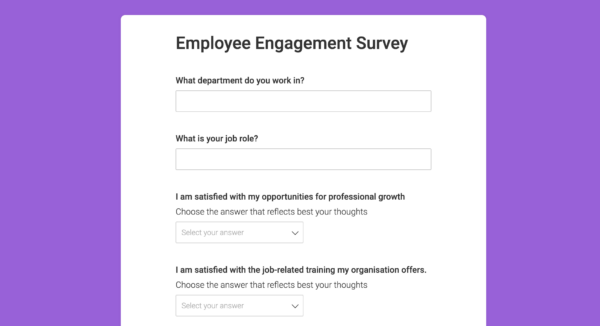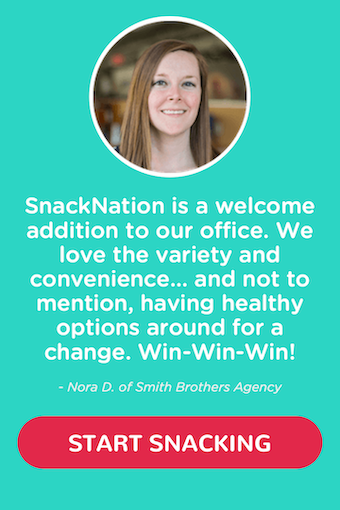
According to Gallup research, companies that ranked the highest levels of employee engagement were 22% more profitable and 21% more productive than those that ranked the lowest levels.
When employees are engaged at work, morale is higher, they’re absent less often and they’re more productive. In short, investing in your employees pays.
But for most companies, which have a minimal or ineffective employee engagement plan, developing and implementing one can be daunting.
We’ve written an article on how to create an effective employee experience strategy. In this article, we’ll show you how to gain valuable insights from your employees along with short-term initiatives to help you jumpstart the process.
What is an employee engagement action plan?
An employee engagement action plan is your roadmap for boosting morale, improving the culture, and increasing employee retention.
It’s the plan you design from the leadership perspective to review, prioritize, and act on employee feedback.
Why is it important to build an employee engagement action plan?
Operating a successful business requires an action planning process. Period. You plan budgets, future projects, elevation strategies, holidays, vacation time, son on, and so on.
Having a plan for your actionable feedback is no different. These too must be prioritized and considered in relation to other business plans in place.
There are also a number of useful benefits to creating an action plan. Here are 3 clear benefits:
✅ Increased Productivity
When your employees know they’re seen and their voices matter, they’re more connected to their role and naturally happier with their work environment. Happy employees are productive employees.
✅ Lower Attrition and Turnover Rates
A business that supports a healthy company culture finds itself hiring much less often than those that don’t. Presenteeism, burnout, and employee turnover are expensive, so keeping your top talents engaged is a win all the way around.
✅ ROI (Return On Investment)
Investing time and money into employee engagement returns BIG financial gains for your business. With higher engagement comes increased efficiency and revenue growth for your bottom line. So you’re essentially investing in the health and wealth of your organization.
Employee Engagement Action Plan Engagement Strategies
1) Do your research

Understanding where your employee engagement stands currently will better help you move the needle toward improvement. From this point, you can successfully design your ongoing engagement strategy by establishing the goals, budget, and overall direction of your company.
Try this! Collecting effective employee engagement survey results with this customizable template will give you a benchmark on how your workforce really feels. Then, there’s nowhere to go but UP.
2) Identify places where your employees engage with each other

Capitalize on your current connections. Whether working in the office or from home, your employees engage with each other in spaces like team meetings, office events, and recognition platforms. Why not use these everyday interactions to support better engagement?
Try this! If you don’t already have a recognition platform in place, you absolutely should. Giving employees an opportunity to show appreciation to their colleagues for their hard work is a great way to encourage organic collaboration and teamwork.
If you want to try out a few top-rated platforms, here is a quick breakdown:
| Motivosity | 🥇 Recognize and reward employees for their achievements and milestones | Visit Motivosity |
| Goody | 🎁 Let them choose their own gift | Visit Goody |
| Stadium | 🌟 Engage and retain employees with recognition, rewards, swag, and more | Visit Stadium |
| Swag.com | 🧢 Create a custom swag box or send gifts directly to employees, clients, and customers | Visit Swag.com |
| Nectar | 😃 Peer-to-peer recognition, Amazon integration, boost your engagement and retention | Visit Nectar |
| 👉 Compare more HR-vetted and approved options here | ||
3) Harness the power of templates
Templates just make life easier. From job applications to project planning, action plan templates can save your employees a TON of time on administrative tasks.
Try this! Take a look at this engagement survey template to see just how easy it can be to use templates for collecting valuable responses from your employees.
4) Incentivize participation

Creating a “pay to play” engagement strategy isn’t just about checking boxes to earn cash rewards. Incentivizing your employees’ participation can look like social recognition, nonmonetary rewards, and exclusive perks for reaching specified milestones.
Try this! Poll the audience to find out the most effective approach for your unique workforce. Then check out some free trials and demos of recognition and incentive programs to see which best fits your feedback.
5) Build engagement initiatives into your company’s OKRs

Setting up your OKRs with engagement in mind is a recipe for success. Showing your employees the bigger company goals, and how their quantitative accomplishments lead to higher-level wins, affords a deeper connection to the organization and sense of purpose. They’re not just a cog in the machine.
Try this! Let the employees set their OKRs. That’s right! They’re in the trenches, doing “the things” that lead to reaching the high-score goals. Who knows better than them how to creatively and efficiently get “there?”
6) Be transparent

Transparency from the top down offers employees a work environment where they too can communicate openly. This approach provides so many opportunities for creativity to bloom, engagement levels to amplify, and the culture to strengthen.
Try this! Check in with your employees more often. Follow up with one-on-ones to discuss their specific concerns, pain points, and aspirations. All while setting clear expectations and achievable goals for them, and communicating openly about the good, the bad, and the ugly.
7) Reinforce your core values through action

As a leader, you can’t just talk the talk. It’s imperative that you believe in and promote the company’s core values because… they’re watching. You gotta walk the walk, my friend! Likewise, employees who demonstrate their alignment with your company’s vision should be recognized as well.
Try this! Reward your employees for their commitment to the company’s core values. This sends a clear message of acknowledgment and appreciation. Bonus! It also motivates others to do the same.
Employee Engagement Action Plan Examples
In this age of immediate gratification, people want results…and fast. So give them some. Below are a list of short-term examples that you can implement in order to start the process of improving your employee engagement with a bang!
➤ Send out an employee engagement survey

We know these can take some work to create. Get initial feedback from junior employees and senior leadership before developing this survey. But also get it out ASAP–the sooner employees start feeling heard, the better!
For help creating an employee engagement survey, see the below section, “2. Solicit employee feedback.” Once the survey is conducted, acting on this feedback is crucial to build engagement and make positive changes at the company.
➤ Start a weekly “Crush It” call
Every Friday at SnackNation, the company comes together to celebrate employee accomplishments.
That is when an employee does something really well or has an impact on the business. Many of our team members say that this event is the one they look forward to the most every week.
Why? Because people love it when their accomplishments and hard work are acknowledged. They also enjoy being part of a community where they can celebrate their colleagues’ wins. It’s not a competitive event, but instead demonstrates that one person’s win is our collective win.
➤ Remind managers to deliver frequent feedback
It’s important that employees feel they’re receiving regular feedback from their managers, whether it’s positive or negative. According to research, 65% of employees want more feedback from managers and 69% of employees report that they’d work harder if they felt their efforts were better recognized.
According to a McKinsey report, every stellar employee experience makes individuals feel they’re doing purposeful work and are encouraged by managers who provide regular coaching on their work. Remind your managers to make a point of this in weekly meetings, daily huddles, and even via email.
➤ Let your employees pick their “Star of the week”
What makes employee recognition special? It’s the thoughtful kudos from peers that make an impact. But how do you get coworkers to recognize each other?
Using a social intranet platform, like Empuls, can bring your employees together to have a fun voting discussion at the end of each week to name the 🌟 “Star of the week”🌟.
Ask for nominations on who excelled the most at work that week and initiate a candid chatter around it. Encourage employees to tag their peers, vote for their pick & bestow the winner of each week with fun titles.
➤ Set up a company Facebook
A Facebook in the old sense of the word! Create a directory with photos and bios of everyone in the company. This gives people an opportunity to familiarize themselves with others in the company and a way to share information about who you are outside of the office.
➤ Start a culture club

Again, employees want to feel heard. So listen to them! Give them a say in the cultural happenings of the company.
What events do you throw? How frequent are they? Which charities does the company do volunteer days with? Make select employees the authority on this matter. Culture clubs are also great because they consist of a cross-departmental group of people.
Each brings a different and unique perspective on the company. Also, they serve as great advocates who can attain perspectives and buy-in from their respective parts of the company.
➤ Make an honesty box
Remember the honesty box feature on Facebook where anyone could tell you something anonymously? Those were scary, we know. We’re not suggesting necessarily making this one anonymous, but instead creating an online form where people can send suggestions for organizational improvements. It provides employees with an easy way to air grievances or share ideas, and gives you a pulse on what people’s concerns are.
6 Steps To Following An Effective Employee Engagement Action Plan
Every company faces a different set of challenges when it comes to employee engagement. Regardless of what you’re looking to accomplish with your Employee Engagement Action Plan, here are six key steps that ensure all of your efforts pay off.

1. Determine what you’re trying to accomplish
Before you even start gathering data, bring together the key leaders of the project to discuss and record what you’re broadly working to accomplish with your employee engagement initiative.
Is your company seeking greater employee retention, boosted morale or more top talent referrals? It’s useful to have a sense of this before you dive in and will help you gain the most helpful insights from your team. Don’t hesitate to involve senior leadership across the company in locking in these objectives.
2. Solicit employee feedback
Engage employees regularly, whether that be with frequent engagement surveys or culture lunches, where you chat with employees about the company’s strengths and weaknesses. Do whatever it takes to keep a pulse on employee sentiment and make employees feel heard.
Employee surveys are still one of the best ways to measure employee engagement. Facebook found that simply asking employees how long they intend to stay at the company using engagement surveys is the most accurate predictor of turnover (more so than machine learning forecasts by leaders in predictive analytics).
So just ask! Surveys provide a platform for employees to be heard, and provide you with insight into employee experience that can help you change future behavior.

Take note of the percentage of employees that don’t participate in the survey. Facebook discovered that those that didn’t participate in surveys were 2.6 times more likely to leave the company in the six months following.
If you’d like to send out a survey but don’t know where to start, asking some broad employee engagement questions will give you clues into company pain points and strengths.
Here’s a list of questions to start with. And here’s a communications plan for sharing goals with senior leadership and your broader employee base before, during and after gathering data. Explain why the company is developing this employee engagement initiative and how it impacts their experience.
3. Analyze your data
Now that you have your data, you have the fun job of analyzing it, spotting trends and determining how you can best improve employee experience.
According to research by McKinsey, a great employee experience always consists of the three elements below. Keep these in mind when analyzing your employee data and aim to create initiatives that optimize all three.
- Each employee does “purposeful work for meaningful rewards and recognition, encouraged by managers who provide regular coaching and feedback.”
- “Teams are empowered to make decisions, operate with trust, and employ user-friendly ways of working and processes.”
- “The company provides a positive workplace environment and culture that reinforces its DNA.”
Nowadays, employees aren’t content having a standard job where they punch in and punch out. Harvard Business Review research supports McKinsey’s claims. Employees are looking for autonomy, impact and flexibility.
For this reason, employees deliver the best results for their company when they do purposeful work for which they receive recognition, get regular feedback from their managers, are empowered to make decisions and have a say over their workplace environment. Employee engagement is about empowering the employee so that he or she can deliver results for your company. Optimize for this when designing your employee engagement initiatives.
4. Design your initiatives
Now that you know what areas of the employee experience need attention, it’s time to design a set of initiatives–an action plan.
What issues needed attention according to employee engagement data? Identify areas for improvement. From here, develop proposed solutions. Keep in mind that improving upon an aspect of company culture employees already appreciate can be as effective a way to enhance engagement as improving upon troubled areas of the employee experience.

When developing your initiatives, ensure that they relate directly back to feedback from your research and aim to solve problems in a practical way. Each should have:
- A clear objective. Effective engagement action plans are SMART: specific, measurable, relevant, achievable and time-bound.
- Success measures so you can calculate improvement
- Ownership so it’s clear who is accountable for seeing each project through
- A timeline for completion.
5. Get feedback on the effectiveness of your initiatives
An initiative isn’t worth much if it’s not actually improving the employee experience. A crucial part of the employee engagement process is getting feedback once you’ve implemented your initiatives.
That being said, the most effective employee engagement initiatives are those that aim to empower the employee and create long-term change, which doesn’t happen overnight. So ask for feedback and take it into account, but know when to stand your ground regarding projects that will have a long-term impact.
A classic feedback mechanism is an employee survey. These work well, but don’t stop there–make multiple feedback portals. Immediately after the launch of an initiative might be the perfect time to start hosting culture lunches, create an online form where employees can make suggestions, or even speaking with individuals one-on-one to discuss culture. Try out different methods to determine what works best for your company.
6. Start over
Employee engagement work is never done. It’s always a work in progress because workplaces and employees are constantly changing! While this may require more work, it is the companies that consistently seek employee feedback and address concerns that can expect to see higher retention and overall happiness among their teams. Keep it up, your work will pay off!

A Harvard Business Review study reveals that companies that invest in employee experience are “28 times as often among Fast Company’s Most Innovative Companies, 11.5 times as often in Glassdoor’s Best Places to Work, 2.1 times as often in Forbes’s list of the World’s Most Innovative Companies, 4.4 times as often in LinkedIn’s list of North America’s Most In-Demand Employers, and twice as often in the American Customer Satisfaction Index.” We think the numbers speak for themselves.
What are you doing to improve the employee experience? Share what methods you’ve loved in the comments below!
People Also Ask These Questions About Employee Engagement Action Plans
Q: What are some examples of an employee engagement action plan?
- A: Some examples of employee engagement action plans are clearly defining your company’s goals, mapping out the steps necessary to reach them, prioritizing tasks and responsibilities, and determining how you plan to monitor progress.
Q: What are the benefits of employee engagement planning?
- A: The benefits of employee engagement planning are transparent communication, improved employee morale and engagement, and lower employee turnover rates.
Q: How does an action plan improve employee engagement?
- A: An action plan improves employee engagement by connecting employees to the bigger purpose of their roles. All the players on the field should understand their assignment and how they help win the game.
Q: How do I develop an employee engagement plan?
- A: You can develop an employee engagement plan by starting with an employee survey. This survey data will set your benchmark so you know the actual condition of your company culture.








This is great – thanks!